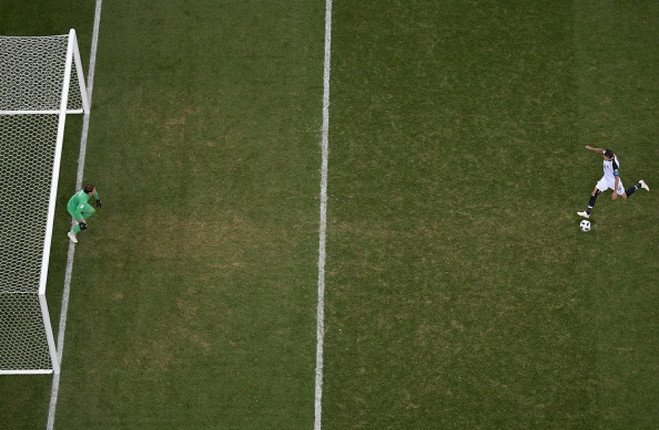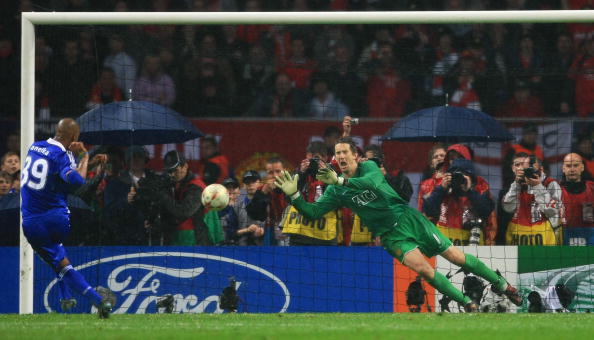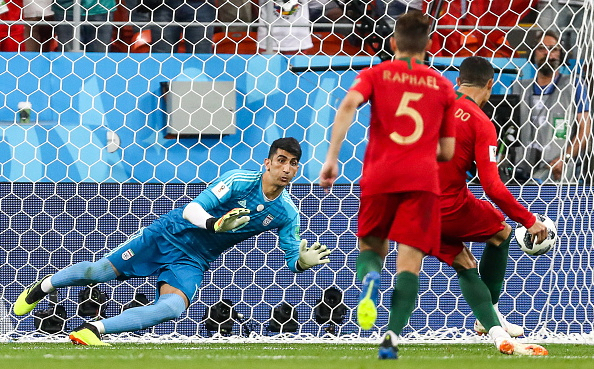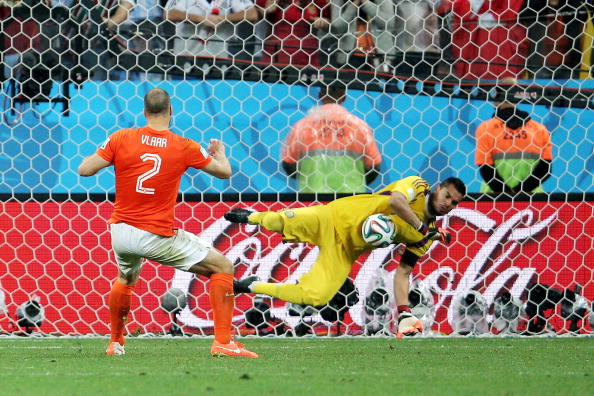ONE OF THE biggest football myths is that the penalty kick is all about luck.
You hear it a lot. From commentators and analysts who discuss the ‘lottery’ of a shoot-out to the players themselves.
At the last World Cup, Argentina goalkeeper Sergio Romero saved two in the semi-final against the Netherlands but still spoke of how penalties were all about good fortune and divine inspiration.
“I had confidence and thanks to God it turned out well,” he said afterwards.
But, he also had notes and studied them before stopping efforts from Ron Vlaar and Wesley Sneijder.
This is the data era. Anything that can give teams an advantage should be exploited. Stakeholders still try and argue but the reality is that there is a science to penalties, patterns that can be analysed and prepared for.
And as the 2018 tournament gets set for the knockout rounds, we can expect to see even more of them from here on.
So, what do we know about the kicks taken so far? And what does that tell us about what’s still to come?
Ignacio Palacios-Huerta is the penalty doctor. In the mid-1990s, the Basque native was a graduate student at the University of Chicago when he began to record penalties in an effort to better understand them. In 2003, his fascinating paper – Professionals Play Minimax – applied economic theory to penalty kicks.
A professor at the London School of Economics, he has repeatedly studied them and is the definitive voice. He carries such an authority that various clubs and international sides have approached him for help.
Famously, Palacios-Huerta advised Chelsea on penalty strategy before the 2008 Champions League final in Moscow. One of his findings was that when Cristiano Ronaldo paused in his run-up, he waited for the goalkeeper to make a move and then put the ball to the goalkeeper’s right.
Another finding was that Edwin van der Sar rarely dived to his left, preferring to gamble on the majority of kick-takers being right-footed and the likelihood they would send their effort to their ‘natural’ side, e.g, wrapping their foot around the ball rather than the more difficult, ‘non-natural’ alternative of opening their body up before shooting to the goalkeeper’s left. He also found that the bulk of van der Sar’s penalty saves came from kicks aimed at mid-height. To beat him, the kicks needed to go very low or very high.
In the subsequent shoot-out, Palacios-Huerta’s research proved impeccable.
Ronaldo paused in his run-up, attempting the bluff. But Petr Cech didn’t move. Taken aback, Ronaldo struck a poor kick to Cech’s right and the goalkeeper saved it.
All of Chelsea’s takers respected the research. When John Terry stepped up to win the competition for his club, he followed Palacios-Huerta’s information and kicked to his ‘non-natural’ side. As usual, van der Sar went the opposite way but Terry slipped on the sodden Moscow turf and the effort struck the outside of the post.
And when Nicolas Anelka had to score his sudden-death kick, he had a dilemma. As he walked up, van der Sar pointed at the left corner of his goal, where all of the Chelsea penalties had gone. Had he finally fastened onto the strategy? If so, what should Anelka do? Well, if he followed Palacios-Huerta’s advice, he would’ve kept with the plan but made sure his effort was very low or very high. Instead, he completely fell apart. A right-footed taker, he gambled on shooting to his ‘natural’ side and sending the kick to van der Sar’s right. What compounded the error was that the effort was mid-height. The keeper saved easily and United were champions.
The patterns and the trends. The extra edge. It’s what all World Cup teams will be looking for, especially when VAR has meant many more penalties being awarded than ever before, not to mind the inevitability of shoot-outs.
When Lionel Messi (v Iceland) and Cristiano Ronaldo (v Iran) had penalties saved during the group stage, both players struck their kicks to their ‘unnatural’ sides. For Messi, a left-footer, he opened his body up and placed the ball to the goalkeeper’s right. For Ronaldo, a right-footer, he did likewise, preferring not to whip his right foot around the ball and instead pushing it to the goalkeeper’s left. In both instances the effort was saved.
When Gylfi Sigurdsson missed against Nigeria, he opened up his body – like Ronaldo – and sent the kick to the goalkeeper’s left. But it was too high. Still, a few days later against Croatia, he kept the same strategy and scored.
To the untrained eye, it looked like a possible trend. Kickers favouring their unnatural side more often.
But, Palacios-Huerta has crunched the numbers to reveal a wider picture.
Breakdown
“24 penalty kicks have been taken,” he says.
“In what follows, the direction (‘right’, ‘left’, ‘centre’) is always from the perspective of the goalkeeper (for both the keeper and penalty taker).”
The 24 penalties so far at the #WorldCup pic.twitter.com/hvY4mnKRHP
— PenaltyKickStat (@PenaltyKickStat) June 28, 2018
Kickers
Kickers have chosen the right side: 9/24 times
Kickers have chosen centre: 2/24 times
Kickers have chosen the left side: 13/24 times
Goalkeepers
Goalkeepers have chosen the right side: 15/24 times
Goalkeepers have chosen centre: 1/24 time
Goalkeepers have chosen the left side: 8/24 times
“It would seem the goalkeepers are ‘overvaluing’ the right side, relative to what the kickers are doing,” Palacios-Huerta says.
“But this is incorrect. And the reason for that is the kicking leg. So, lets look at the data taking into account the kicking leg being used by the takers.
In what follows: ‘N’ is the natural side, ‘NN’ is the non-natural side and ‘C’ is centre, again always from the perspective of the goalkeeper for both the kicker and the goalkeeper.
And, just to clarify, ‘Natural side’ is right for a right-footed kicker and left for a left-footed kicker. ‘Non-Natural side’ is left for a right-footed kicker and right for a left-footed kicker.”
Kickers
Kickers have chosen N (natural side): 13 times
Kickers have chosen C (centre): 2 times
Kickers have chosen NN (non-natural side): 9 times
Goalkeepers
Goalkeepers have chosen N (natural side): 14 times
Goalkeepers have chosen C (centre): 1 time
Goalkeepers have chosen NN (non-natural side): 9 times
Patterns
“This gives a much better, and different, picture!” Palacios-Huerta says.
“Goalkeepers are essentially choosing sides with the same frequencies as kickers. And they are pretty good from this perspective.
In terms of guessing the correct side, goalkeepers have done it with 10 out of the 24 kicks taken, which is slightly below the 48-50% expected rate.”
So, to conclude, as much as kickers like Messi and Ronaldo have been caught out when going to their unnatural side and trying to surprise the goalkeeper, there hasn’t been a major spike in keepers’ guessing correctly.
At this tournament, even with some high-profile misses, the kicker still has the edge. So far.
Shoot-outs
As the tournament progresses through the knockout rounds, one thing can almost be guaranteed: shoot-outs will feature prominently.
One crucial element in this World Cup edition – and something that, perhaps, has slipped between the cracks – is the ordering of penalties during a shoot-out.
The relentless research carried out by Palacios-Huerta found that the most important moment of any shoot-out was the coin toss. Because, whoever decided to kick first had such a distinct advantage: generally agreed to be 60%.
In that 2008 Champions League final, United captain Rio Ferdinand won the shoot-out toss. But he was unsure of what to do, a reflection of how unprepared his team was for such an eventuality. In contrast, his counterpart Terry – clearly knowing the importance of taking the first kick – offered that Chelsea go first. Ferdinand turned to get the advice of coaching staff and only then did United decide to take the first kick.
In the Argentina/Netherlands shootout in 2014, the Dutch went first but Vlaar saw his kick saved by Romero. When Messi scored the next penalty, the 60% – 40% advantage the Dutch had before the shootout began had turned into a 31% – 69% disadvantage. And in the space of just two kicks.
Palacios-Huerta repeatedly spoke of the advantage teams had when kicking first in a shoot-out. It was back in 2010 when he and his co-author Jose Apesteguia initially published their research on it, having studied thousands of shoot-outs from 1970 up to 2008. Further to that, they spoke to 240 players and coaches who almost all said they would prefer to take the first kick. When asked why, 96% of them reasoned that it would put pressure on the team kicking next.
Palacios-Huerta wanted football officials to level the playing field and urged them to introduce a new shoot-out system, similar to what is used in tennis tiebreaks.
The ‘ABBA’ format was slowly brought in and trialled. Essentially, it means that Team A takes the first kick, but Team B takes the second and third before Team A takes the fourth, etc. Before, the system was ‘ABAB’ and the psychological pressure would always be on the side following the first taker. Essentially, the numbers point to an immediate 60/40 advantage for the team going first. So, shifting the pattern of takers changes that.
The English Football League introduced the ‘ABBA’ system for all their knockout competitions last season while it’s been used in five tournaments too, including the FIFA Under 20 World Cup.
But, it won’t be used in Russia. That’s according to David Elleray, the former referee, who is the technical director of IFAB, the collective that governs football’s laws.
“Most of the research says that under the traditional system if you win the toss and go first you have a 60% chance of winning,” he told The Times earlier this month.
“Under ABBA it’s about 50-50, so empirically it seems fairer, but it is a bit confusing.”
Palacios-Huerta, who is responsible for the football world trialling the new system and moving away from the tried and tested, points to the numbers to illustrate a point.
“Thus far there have been 34 shoot-outs in the ‘ABBA’ trials,” he says.
“17 times the first kicking team won and 17 times the second. So, it seems it’s working very well. But it’s a small sample, I know.”
“ABBA is a superior alternative independent of whether A has an advantage, whether B has an advantage, or whether there is no advantage at all.
If AB favours ‘A’ in the first pair, we should reverse the order in the next pair to favour ‘B’: so AB-BA
If AB favours ‘B’ in the first pair, we should reverse the order in the next pair to favour ‘A’: so AB-BA
If AB does not favour any team, by reversing we are having no impact whatsover.
Hence, ABBA is a win-win improvement over ABAB, although people seem not to realise this.”
The reluctance of Fifa to introduce the ABBA system for this World Cup means teams going first in a shoot-out will continue to have a 60% advantage and the coin toss will continue to be the most important moment of any shoot-out scenario.
But, are there any other patterns to watch out for when a shoot-out begins?
“In shoot-outs we should see players choosing the natural side more often,” Palacio-Huerta says.
“The reason is that shoot-outs involve several players, many of whom are less frequent (or more infrequent) players, which tend to choose the natural side more often than more expert players (which typically choose around 60-40). In turn, goalkeepers tend to know this, and also tend to choose the natural side slightly more often.”
The42 is on Instagram! Tap the button below on your phone to follow us!






